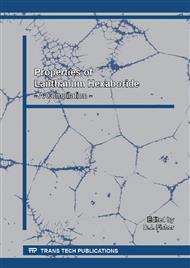[1]
Fleischer, R.L., Price, P. B. and Walker, R. M. (1975). Nuclear Tracks in Solids, University of California Press, Berkeley, CA, pp.159-590.
Google Scholar
[2]
Atul Kulkarni, A., Vyas, C. K., Kim, H., Kalsi, P. C., Kim, T., Manchanda, V. (2012) Sensors and Actuators, B161, 697.
Google Scholar
[3]
Michael F. L'Annunziata, (2012). Handbook of radioactivity analysis, third edition, Elsevier Inc, pp.241-248.
Google Scholar
[4]
El-Farrash, A. H., Yousef, H. A. and Hafez A.F. (2012). Radiation Measurements 47, 644.
Google Scholar
[5]
Ismail, A. H. (2009). Nucl. Instrm. and Methods in Physics Research B 267, 3209.
Google Scholar
[6]
Brahimi, S., Lounis-Mokrani, Z., Imatoukene, D., Badreddine, A., Abdelaziz, F.Z. and Allab, M. (2008). Radiation Measurements 43, S56.
DOI: 10.1016/j.radmeas.2008.03.075
Google Scholar
[7]
Eissa, M. F. (2008). International Journal of polymeric materials 57, 288.
Google Scholar
[8]
Singh, S. and Neerja, (2007). Radiation Measurements 42, 1507.
Google Scholar
[9]
Yamauchi, T. (2003). Radiation Measurements 36, 73.
Google Scholar
[10]
Lounis, Z., Djeffal, S., Morsli, K. and Allab, M. (2001). Nucl. Instrm. and Methods in Physics Research B 179, 543.
Google Scholar
[11]
Chong, C. S., Chan, M. A. C. and Tan, L.F. (1993). Nucl. Tracks Radiation Measurements 22, 101.
Google Scholar
[12]
Schweikani, R., Durrani, S. A. and Tsuruta, T. (1993). Nucl. Tracks Radiation Measurements 22, 153.
Google Scholar
[13]
Chong, C. S., Ishak, I., Mahat, R. H. and Amin, Y. M. (1997). Radiation Measurements 28, 119.
Google Scholar
[14]
Nikezic, D. and Yu, K. N. (2004). Materials Science and Engineering R46, 51.
Google Scholar
[15]
Durrani, S.A. and Bull, R. K. (1987). Nuclear Track Detection: Principles, Methods and Applications, Pergamon Press, Oxford, pp.52-54.
Google Scholar
[16]
Ramola, R.C., Chandra, S., Negi, A., Rana, J. M. S., Annapoorni, S., Sonkawade, R. G., Kulriya, P. K. and Srivastava, A. (2009). Physica B 404, 26.
DOI: 10.1016/j.physb.2008.09.033
Google Scholar
[17]
Zaki, M.F. (2008). J. Phys. D: Appl. Phys. 41, 175404.
Google Scholar
[18]
Singh, S. and Prasher, S. (2005). Radiation Measurements 40, 50.
Google Scholar
[19]
Phukan, T., Kanjilal, D., Goswami, T.D. and Das, H.L. (2003). Radiation Measurements, 36, 611.
Google Scholar
[20]
Virk, H. S. and Srivastava, A. K. (2001). Radiation Measurements 34, 65.
Google Scholar
[21]
Enge, W.(1980). Nuclear track 4, 283.
Google Scholar
[22]
Kocsis, Zs., Dwivedi, K.K. and Brandt, R. (1997). Radiation Measurements 28,177.
Google Scholar
[23]
Khayrat, A.H. and Durrani, S.A. ( 2003). Radiation Measurements 30, 15.
Google Scholar
[24]
Ziegler, J. F., SRIM-2013, www.SRIM2013.org
Google Scholar
[25]
Nikezic, D. and Yu, K. N. (2006). Computer Phys. Communications 174, 160.
Google Scholar
[26]
Kumar, R., Rajguru, S. and Das, D., Prasad, R. (2003). Radiation Measurements 36, 151.
Google Scholar
[27]
Gaffar, M. A. and Abu El-Fadl. (1999). Crystal research technology 34(7), 915.
Google Scholar
[28]
Urbach, F. (1953). Phys. Rev. 92, 1324.
Google Scholar
[29]
Singh, S., Prasher, S. (2006). Nucl. Instrm. and Methods in Physics Research B, 244, 252.
Google Scholar
[30]
Fleischer, R. L., Price, P. B. and Woods, R. T. (1969). Phys. Rev. 188(2), 563.
Google Scholar


